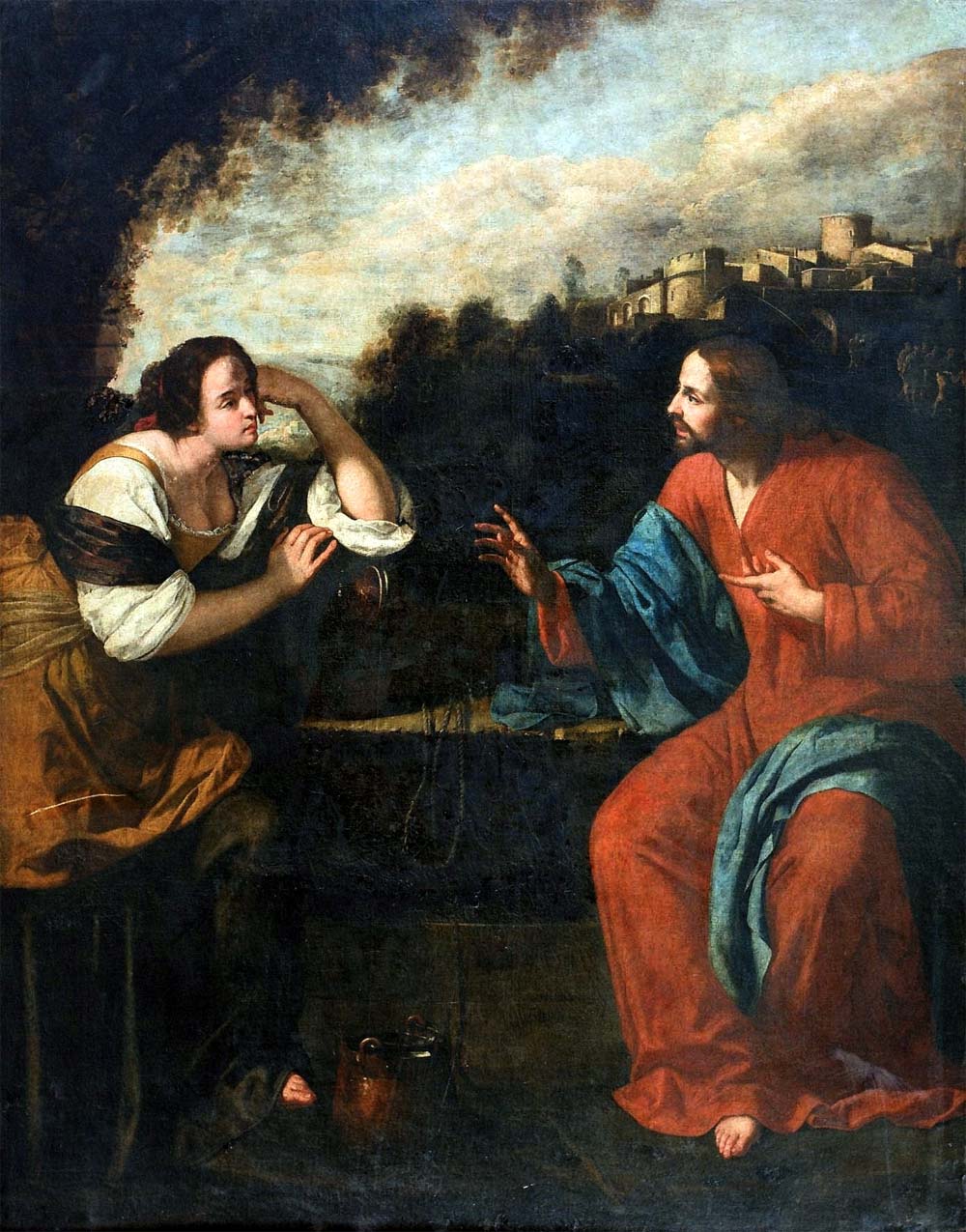The Museum of Palazzo Blu in Pisa has been enriched with a work by Artemisia Gentileschi (Rome, 1593 - Naples, 1654): it is Christ and the Samaritan Woman at the Well, dated 1636-1637, which was purchased for the museum by the Pisa Foundation (it was previously in a private collection). The large work (over two and a half meters high by two meters wide), which is in an excellent state of preservation, was painted by Artemisia during her long and productive stay in Naples: in fact, the painter resided in Naples from 1630 until her death.
The work was identified in 2007 by Luciano Arcangeli, and exhibited for the first time on the occasion of the exhibition Artemisia Gentileschi. Storia di una passione, curated by Roberto Contini and Francesco Solinas, and held in Milan’s Palazzo Reale between September 2011 and January 2012, with subsequent replication in Paris. According to Arcangeli, this is one of the “large paintings” mentioned by Artemisia Gentileschi in two letters written in the fall of 1637 to the nobleman Cassiano del Pozzo, in which the painter wanted to propose for purchase, precisely, the two paintings to the cardinals Francesco and Antonio Barberini, and asked for Cassiano dal Pozzo’s intercession (Artemisia in fact needed money because her daughter was to be married). In one of the two letters, the work purchased by the Pisa Foundation is mentioned as “the Samaritan with the Messiah, and his twelve Apostles, with countries far and near, etc., adorned with much vagueness.”

In all likelihood, Artemisia failed to sell the painting since the Barberini inventories never mention a painting of hers with such a subject, yet it coincides well with the description given in the letter (we see Christ and the Samaritan woman, the “countries far and near,” and also the twelve apostles coming out of the city gate, on the right). The identification was thus made possible by matching the written source, as well as by stylistic comparisons with other works by Artemisia from the same period, above all the Birth of the Baptist painted for the Buen Retiro in Madrid, and the paintings for Pozzuoli Cathedral. “It is, in short,” Arcangeli wrote, “a product, and among the highest, of the artist’s early Neapolitan period, destined to end in 1639 with Artemisia’s departure for England,” that is, of the period in which the painter, “until then mainly occupied in room paintings or otherwise destined for private collecting, tackles the altarpiece (and thus the language of public devotion). It is probably this new dimension, in which Artemisia perhaps does not move completely at ease, that leads the artist toward more composed solutions, compositions that are often paratactic, choices that are sometimes archaizing [...] which may disorient the observer and justify certain reservations about including the painter among the tout court protagonists of the fervent season that from the passage of Caravaggio onwards filled the churches of Naples with an extraordinary series of new images of the sacred.” The painting in question, however, according to Arcangeli, eschews these flaws, since “the powerful effect it communicates is centered above all on the formidable female figure, the unforgettable sister of so many of Gentileschi’s heroines, like these characterized by a heaviness of features and forms, of a lazy expansion that conceals refined energy. A strength underscored by the highly studied colors, though lacking the preciousness of the works of the Florentine period, and the ”closed and monumental" form of the Samaritan woman.
We do not know what historical events affected the painting, which was in Palermo at the time of its purchase by the Pisa Foundation. It is likely that throughout its history it never left the territories of the ancient kingdom of Naples. It was certainly for a time in the collection of the Oneto dukes of Sperlinga, and it also passed through the family palace near Porta Maqueda in Palermo (in the 19th century, however, it was recorded as a work by Luca Giordano: today, however, there are no doubts about its authorship).
After it was purchased by the Foundation in late spring of this year, the Christ and the Samaritan Woman underwent a thorough cleaning and restoration conducted by a team of restorers led by Cinzia Pasquali, with Elisa Todisco, Elena Burchianti and Enrico Rossi, under the high supervision of the Superintendency of Pisa. The intervention unveiled “sensational new discoveries” (so Palazzo Blu in a note) that further reaffirm the painting’s authorship.
The large canvas will be presented to the public on Thursday, Nov. 17, 22 at 5 p.m. in the halls of the Palazzo Blu museum, with a seminar open to the public at which the president of the Pisa Foundation, Stefano Del Corso, and the president of Palazzo Blu, Cosimo Bracci Torsi, will speak, along with Professor Francesco Solinas and scholars Angheli Zalapì and Edoardo Bassetti, and the painting’s restorers Elisa Todisco, Enrico Rossi, and Elena Burchianti. Stefano Renzoni will present the meeting, followed by a tour of the painting. Reservations to attend the event are strongly recommended, writing to segreteria@palazzoblu.it. The results of the study and restoration are presented in a volume published by De Luca editori d’arte, which will be available in the Blu Book bookstore in Palazzo Blu. Finally, from Friday, Nov. 18 to Sunday, Nov. 20, Christ and the Samaritan Woman at the Well will be on view free of charge within Palazzo Blu’s permanent collection during the museum’s usual opening hours (Friday from 10 a.m. to 7 p.m.; Saturday and Sunday from 10 a.m. to 8 p.m.).
 |
| Pisa, Palazzo Blu acquires important work by Artemisia Gentileschi |
Warning: the translation into English of the original Italian article was created using automatic tools. We undertake to review all articles, but we do not guarantee the total absence of inaccuracies in the translation due to the program. You can find the original by clicking on the ITA button. If you find any mistake,please contact us.